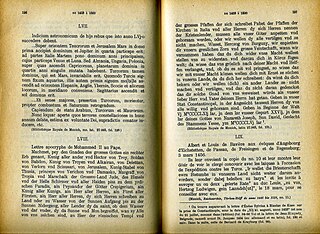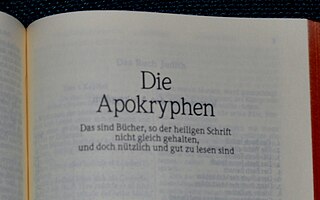
In the early part of the sixteenth century, there were already attempts to translate the Bible into Yiddish, including Hebrew-Yiddish biblical dictionaries. [1] One of the most authoritative was the Bible that Jekuthiel Blitz translated in 1678.

In the early part of the sixteenth century, there were already attempts to translate the Bible into Yiddish, including Hebrew-Yiddish biblical dictionaries. [1] One of the most authoritative was the Bible that Jekuthiel Blitz translated in 1678.
There are numerous Biblical translations in Yiddish because it constituted the very beginning of its literature along with other the religious texts such as the Talmud. [2] Scholars explained that this can be attributed to the fact that the Bible is a popular book among the Jewish communities in Germany and surrounding European countries and it was also a reference for the early education of young Jews there. [3]
There were different translation style such as the so-called Ashkenazi literary tradition, more popularly known as taytsh-khumesh, which translated the Bible literally. Here, the words in the Hebrew original were translated into their Yiddish counterparts. [4] While this method was widely criticized, mainly for its strict adherence to the literal meaning of the text, it proved useful particularly for theologians and Hebraists who needed sources in their effort to understand of the literal sense of the Bible. [5]
Jekuthiel Blitz, who was a rabbi from Wittmund, Germany, published his work with the backing financial backers such as Aharon Hart, who obtained haskomes for the undertaking from the Council of the Four Lands, the central governing body of Polish Jews. [6]
A notable milestone in the historical development of the Yiddish Bible involved Solomon Bloomgarden's initiative. His translation is considered to be the most comprehensive and was published under his pen name Yehoesh. [7] The text is regarded as both literary and scholarly, influenced the work of Yiddish scholars in the nineteenth century.

Apocrypha are biblical or related writings not forming part of the accepted canon of Scripture. While some might be of doubtful authorship or authenticity, in Christianity, the word apocryphal (ἀπόκρυφος) was first applied to writings which were to be read privately rather than in the public context of church services. Apocrypha were edifying Christian works that were not considered canonical scripture. It was not until well after the Protestant Reformation that the word apocrypha was used by some ecclesiastics to mean "false," "spurious," "bad," or "heretical."

The Bible is a collection of religious texts or scriptures, some, all, or a variant of which, are held to be sacred in Christianity, Judaism, Samaritanism, Islam, the Baha'i Faith, and many other Abrahamic religions. The Bible is an anthology, a compilation of texts of a variety of forms, originally written in Hebrew, Aramaic, and Koine Greek. These texts include instructions, stories, poetry, and prophecies, and other genres. The collection of materials that are accepted as part of the Bible by a particular religious tradition or community is called a biblical canon. Believers in the Bible generally consider it to be a product of divine inspiration, but the way they understand what that means and interpret the text varies.

The Book of Nehemiah in the Hebrew Bible, largely takes the form of a first-person memoir by Nehemiah, a Jew who is a high official at the Persian court, concerning the rebuilding of the walls of Jerusalem after the Babylonian exile and the dedication of the city and its people to God's laws (Torah).
The deuterocanonical books are books and passages considered by the Catholic Church, the Eastern Orthodox Church, the Oriental Orthodox Churches, and/or the Assyrian Church of the East to be canonical books of the Old Testament, but which Jews and Protestants regard as apocrypha. They date from 300 BC to 100 AD, before the separation of the Christian church from Judaism. While the New Testament never directly quotes from or names these books, the apostles quoted the Septuagint, which includes them. Some say there is a correspondence of thought, and others see texts from these books being paraphrased, referred, or alluded to many times in the New Testament, depending in large measure on what is counted as a reference.
The Old Testament (OT) is the first division of the Christian biblical canon, which is based primarily upon the 24 books of the Hebrew Bible, or Tanakh, a collection of ancient religious Hebrew and occasionally Aramaic writings by the Israelites. The second division of Christian Bibles is the New Testament, written in Koine Greek.

The Septuagint, sometimes referred to as the Greek Old Testament or The Translation of the Seventy, and often abbreviated as LXX, is the earliest extant Greek translation of the Hebrew Bible from the original Hebrew. The full Greek title derives from the story recorded in the Letter of Aristeas to Philocrates that "the laws of the Jews" were translated into the Greek language at the request of Ptolemy II Philadelphus by seventy-two Hebrew translators—six from each of the Twelve Tribes of Israel.

The Haskalah, often termed as the Jewish Enlightenment, was an intellectual movement among the Jews of Central and Eastern Europe, with a certain influence on those in Western Europe and the Muslim world. It arose as a defined ideological worldview during the 1770s, and its last stage ended around 1881, with the rise of Jewish emancipation.
The name "Esdras" is found in the title of four texts attributed to, or associated with, the prophet Ezra. The naming convention of the four books of Esdras differs between church traditions; and has changed over time.

Hebrew literature consists of ancient, medieval, and modern writings in the Hebrew language. It is one of the primary forms of Jewish literature, though there have been cases of literature written in Hebrew by non-Jews. Hebrew literature was produced in many different parts of the world throughout the medieval and modern eras, while contemporary Hebrew literature is largely Israeli literature. In 1966, Agnon won the Nobel Prize for Literature for novels and short stories that employ a unique blend of biblical, Talmudic and modern Hebrew, making him the first Hebrew writer to receive this award.
Hebrew Bible English translations are English translations of the Hebrew Bible (Tanakh) according to the Masoretic Text, in the traditional division and order of Torah, Nevi'im, and Ketuvim. Most Jewish translations appear in bilingual editions (Hebrew–English).

Jewish literature includes works written by Jews on Jewish themes, literary works written in Jewish languages on various themes, and literary works in any language written by Jewish writers. Ancient Jewish literature includes Biblical literature and rabbinic literature. Medieval Jewish literature includes not only rabbinic literature but also ethical literature, philosophical literature, mystical literature, various other forms of prose including history and fiction, and various forms of poetry of both religious and secular varieties. The production of Jewish literature has flowered with the modern emergence of secular Jewish culture. Modern Jewish literature has included Yiddish literature, Judeo-Tat literature, Ladino literature, Hebrew literature, and Jewish American literature.

The biblical apocrypha denotes the collection of apocryphal ancient books thought to have been written some time between 200 BC and AD 100. The Catholic, Eastern Orthodox and Oriental Orthodox churches include some or all of the same texts within the body of their version of the Old Testament, with Catholics terming them deuterocanonical books. Traditional 80-book Protestant Bibles include fourteen books in an intertestamental section between the Old Testament and New Testament called the Apocrypha, deeming these useful for instruction, but non-canonical. To this date, the Apocrypha are "included in the lectionaries of Anglican and Lutheran Churches". Anabaptists use the Luther Bible, which contains the Apocrypha as intertestamental books; Amish wedding ceremonies include "the retelling of the marriage of Tobias and Sarah in the Apocrypha". Moreover, the Revised Common Lectionary, in use by most mainline Protestants including Methodists and Moravians, lists readings from the Apocrypha in the liturgical calendar, although alternate Old Testament scripture lessons are provided.
The Old Testament is the first section of the two-part Christian biblical canon; the second section is the New Testament. The Old Testament includes the books of the Hebrew Bible (Tanakh) or protocanon, and in various Christian denominations also includes deuterocanonical books. Orthodox Christians, Catholics and Protestants use different canons, which differ with respect to the texts that are included in the Old Testament.
Biblical languages are any of the languages employed in the original writings of the Bible. Partially owing to the significance of the Bible in society, Biblical languages are studied more widely than many other dead languages. Furthermore, some debates exist as to which language is the original language of a particular passage, and about whether a term has been properly translated from an ancient language into modern editions of the Bible. Scholars generally recognize three languages as original biblical languages: Hebrew, Aramaic, and Koine Greek.
Samuel Friedrich Brenz was an anti-Judaism writer, himself born Jewish. He converted to Christianity in 1601 in Feuchtwangen, and wrote Jüdischer Abgestreifter Schlangenbalg, in which he bitterly attacked his former coreligionists, whom he accused of hating "the most pious and innocent Jew, Jesus Christ," and in which he denounced their religious literature. This book, divided into seven chapters, was published in Nuremberg in 1614, 1680, and 1715.
A biblical canon is a set of texts which a particular Jewish or Christian religious community regards as part of the Bible.
Jekuthiel ben Isaac Blitz was a rabbi who made the first whole translation of the Hebrew Bible into Yiddish.
Benjamin Nehemiah Solomon was the first translator of the New Testament into Yiddish, published by the London Jews Society in 1821. Solomon was a Polish-Jewish convert to Christianity who had moved to England. The Hebrew Bible itself had already been translated into Yiddish by Jekuthiel Blitz of Wittmund and printed in Amsterdam in 1679.

Judah Leib Ben-Ze'ev was a Galician Jewish philologist, lexicographer, and Biblical scholar. He was a member of the Me'assefim group of Hebrew writers, and a "forceful proponent of revitalizing the Hebrew language".
Berish Blumenfeld was a Galician Jewish Hebraist.